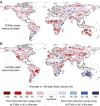Strong influence of El Niño Southern Oscillation on flood risk around the world
- PMID: 25331867
- PMCID: PMC4226082
- DOI: 10.1073/pnas.1409822111
Strong influence of El Niño Southern Oscillation on flood risk around the world
Abstract
El Niño Southern Oscillation (ENSO) is the most dominant interannual signal of climate variability and has a strong influence on climate over large parts of the world. In turn, it strongly influences many natural hazards (such as hurricanes and droughts) and their resulting socioeconomic impacts, including economic damage and loss of life. However, although ENSO is known to influence hydrology in many regions of the world, little is known about its influence on the socioeconomic impacts of floods (i.e., flood risk). To address this, we developed a modeling framework to assess ENSO's influence on flood risk at the global scale, expressed in terms of affected population and gross domestic product and economic damages. We show that ENSO exerts strong and widespread influences on both flood hazard and risk. Reliable anomalies of flood risk exist during El Niño or La Niña years, or both, in basins spanning almost half (44%) of Earth's land surface. Our results show that climate variability, especially from ENSO, should be incorporated into disaster-risk analyses and policies. Because ENSO has some predictive skill with lead times of several seasons, the findings suggest the possibility to develop probabilistic flood-risk projections, which could be used for improved disaster planning. The findings are also relevant in the context of climate change. If the frequency and/or magnitude of ENSO events were to change in the future, this finding could imply changes in flood-risk variations across almost half of the world's terrestrial regions.
Keywords: El Niño Southern Oscillation; climate variability; flood hazard; flood risk; global scale.
Conflict of interest statement
The authors declare no conflict of interest.
Figures



References
-
- McPhaden MJ, Zebiak SE, Glantz MH. ENSO as an integrating concept in earth science. Science. 2006;314(5806):1740–1745. - PubMed
-
- Cane MA, Eshel G, Buckland RW. Forecasting Zimbabwean maize yield using eastern equatorial Pacific sea surface temperature. Nature. 1994;370:204–205.
-
- Pielke RA, Jr, Landsea CN. La Niña, El Niño, and Atlantic hurricane damages in the United States. Bull Am Meteorol Soc. 1999;80(10):2027–2033.
-
- Holgren M, Hirota M, Van Nes EH, Scheffer M. Effects of interannual climate variability on tropical tree cover. Nat Climate Change. 2013;3:755–758.
-
- Coughlan de Perez E, Monasso F, Van Aalst M, Suarez P. Science to prevent disasters. Nat Geosci. 2014;7:78–79.
Publication types
MeSH terms
Substances
LinkOut - more resources
Full Text Sources
Other Literature Sources
Medical
Molecular Biology Databases

